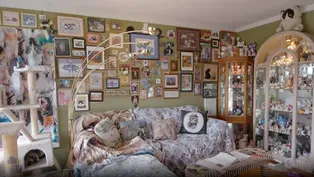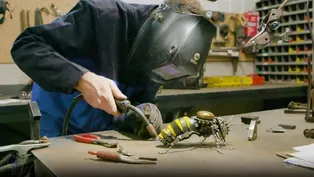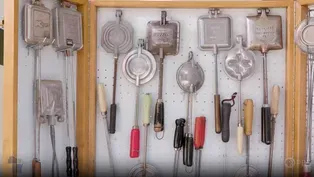
Pioneering Professor of Art
Clip: Season 10 Episode 4 | 3m 55sVideo has Closed Captions
Professor and artist Freida High illuminates her dynamic career in African American art.
For the past 50 years in Madison, Freida High’s had a dynamic career as an artist and professor. In her sprawling studio, High recalls the moment that catalyzed her to study African American art and her days teaching African American art history at the University of Wisconin-Madison. Notably, High explains how she simultaneously maintained an art practice outside of teaching.
Problems with Closed Captions? Closed Captioning Feedback
Problems with Closed Captions? Closed Captioning Feedback
Wisconsin Life is a local public television program presented by PBS Wisconsin
Funding for Wisconsin Life is provided by the Wooden Nickel Fund, Mary and Lowell Peterson, A.C.V. and Mary Elston Family, Obrodovich Family Foundation, Stanley J. Cottrill Fund, Alliant Energy, UW...

Pioneering Professor of Art
Clip: Season 10 Episode 4 | 3m 55sVideo has Closed Captions
For the past 50 years in Madison, Freida High’s had a dynamic career as an artist and professor. In her sprawling studio, High recalls the moment that catalyzed her to study African American art and her days teaching African American art history at the University of Wisconin-Madison. Notably, High explains how she simultaneously maintained an art practice outside of teaching.
Problems with Closed Captions? Closed Captioning Feedback
How to Watch Wisconsin Life
Wisconsin Life is available to stream on pbs.org and the free PBS App, available on iPhone, Apple TV, Android TV, Android smartphones, Amazon Fire TV, Amazon Fire Tablet, Roku, Samsung Smart TV, and Vizio.
Providing Support for PBS.org
Learn Moreabout PBS online sponsorship[upbeat jazz music] - Freida High Wasikhongo Tesfagiorgis: I am a Black woman, artist, mother, professor, curator, art historian.
I'm all of those things.
So, all of those things become a part of me.
[driving jazz rhythm with horns] I began teaching here in 1972.
[edgy jazz] And I taught that for both Afro-American studies and the art department for 41 1/2 years.
This was a period right after the Department of Afro-American Studies began, which was in 1970.
[dramatic jazz] When I started my actual teaching, most of the professors did not have afros.
I was the only person teaching with an afro.
And so, there was a different kind of interaction with me and the young students, too.
By the time I left there, many of the girls in the school in my class had afros.
[electro indie synthesizer] I started on this a while ago, but it got too emotional, so I had to stop.
But the past couple of months, I said, "I keep feeling I gotta get back into that.
So, I'm gonna get back into it."
Now, I'll try to capture some of the essence of joy my mother had.
I'm more interested in being loose with my brush and being expressive.
Afro-American art is more of a sociological term.
Afro-American person who's doing art.
Black art was much more specific related to African American culture, going into cultural heritage, and so on.
Freida: What matters most is that these artists are true to themselves.
They're creating what they want, what they think, what they feel.
They're passionate about what they're doing.
Then, if they are doing Black art, then that means they're actually immersed in a certain kind of work that is embedded or emerging from, or somehow connected to African American experience.
[gentle trumpet and piano] [paper rustling] [trumpet] It's a portrait of my baby brother David, done back around '71, '72.
I like to work with bright colors, bright, bold colors, and quite a bit of rhythm.
[slow, relaxed music] So, those were all people who were lynched in Alabama.
It's supposed to be the tree of life, you know?
A lot of people say, like, in Africa, when a person of importance dies, they say, 'a great tree has fallen.'
And when we think about lynching, it's usually the tree that takes the life.
[gentle piano] When I teach, I don't just teach Los Angeles or New York.
I teach artists who are doing exciting work.
Artists who are doing work in different types of materials and presenting their ideas.
Being an artist and a professor, there is certainly that intersection.
In my case, what I study, what I teach influences my creativity.
Well, all of my work, you can look at it, it's all Black art.
I don't know how anybody would categorize it, but it's me.
It's a part of me and my creativity and my knowledge and my learning.
[gentle jazz]
Video has Closed Captions
Clip: S10 Ep4 | 4m 59s | A Menomonee Falls couple tries to create the world’s greatest cat collection. (4m 59s)
Video has Closed Captions
Clip: S10 Ep4 | 5m 16s | Artist David Groenjes uses scrap metal to sculpt incredible statues and art. (5m 16s)
Video has Closed Captions
Clip: S10 Ep4 | 4m 54s | Baraboo artist Tim Znidarsich demonstrates the intensive process of printmaking. (4m 54s)
Video has Closed Captions
Clip: S10 Ep4 | 4m 32s | Learning to make pudgy pies with the Pudgy Pie Guy is an annual summer tradition at Kohler (4m 32s)
Providing Support for PBS.org
Learn Moreabout PBS online sponsorshipSupport for PBS provided by:
Wisconsin Life is a local public television program presented by PBS Wisconsin
Funding for Wisconsin Life is provided by the Wooden Nickel Fund, Mary and Lowell Peterson, A.C.V. and Mary Elston Family, Obrodovich Family Foundation, Stanley J. Cottrill Fund, Alliant Energy, UW...















